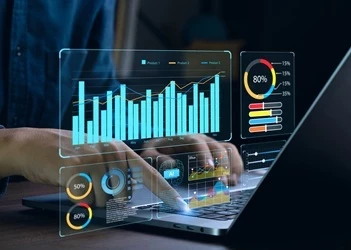ExxonMobil's Well-Oiled Enterprise Data and Analytics Approach
Could Advanced Analytics Help Oil & Gas Companies Make More Money and Go Green? ExxonMobil is Beginning to Find Out
Add bookmark
The largest non-government owned company in the energy sector, Exxon Mobil produces about 3% of the world's oil and roughly 2% of the world's energy. However, in the highly volatile world of oil & gas, even Exxon Mobil can’t rest on its laurels.
With the world demanding more energy at a lower cost and with less emissions, ExxonMobil is looking towards the next generation of data and analytics capabilities to help it achieve those objectives. Today we look at 3 of those initiatives.
Smart Oilfield Innovation
Exxon’s ability to identify and efficiently drill new wells is paramount to its profitability. In the past, discovering new reservoirs required extensive exploratory drilling, a process that was both expensive and destructive.
With the advent of Artificial Intelligence (AI) and advanced analytics, oil & gas companies have been able to significantly reduce the number of exploratory wells they build. As the U.S. Energy Information Administration (EIA) explains, “Satellites, global positioning systems, remote sensing devices, and 3-D and 4-D seismic technologies make it possible to discover oil reserves while drilling fewer exploratory wells. Mobile and smaller slim hole drilling rigs reduce the size of the area that drilling activities affect.”
In partnership with Microsoft Azure, Exxon Mobil is leveraging IoT and machine learning (ML) to minimize downtime and increase productivity by enabling predictive maintenance and dynamic routing of field workers. Using an extensive network of sensors, data is collected and then stored in the cloud. This allows field engineers, scientists, and analysts seamless, to access real-time data from anywhere, anytime.
As Anish Patel, the Permian Digitalization Manager at XTO Energy (a subsidiary of ExxonMobil), explained in a Microsoft blog post promoting the partnership, “We have billions of data points we need to sift through on a day-to-day basis and, using Dynamics 365, we will have efficient ways to access a single source of truth for our data via web and mobile tools, so our employees can do their jobs more effectively. Whether they’re looking at the health of an individual well or the Permian Basin operations as a whole, they can intelligently optimize performance and prioritize new projects. We’re really empowering them to make better decisions.”
ExxonMobil is also working with IBM to apply AI to seismic interpretation. Using IBM cloud technologies, they were able to modernize and centralize ExxonMobil’s data estates into one, easy to access repository. As a result, any team member can collect data from any application from any source and make it available seamlessly through APIs increasing the efficiency of data curation by 40%.
Big Data Increasing Productivity & Cutting Emissions
On December 14, 2020, Exxon Mobil released it’s 2021 Energy & Carbon summary whereby they pledged a 15-20% reduction in upstream greenhouse emissions by 2025 and a 40-50% reduction in methane intensity. The key to accomplishing this? High-performance computing analytics (HPCA).
Back in 2019, Exxon Mobil launched it’s ExxonMobil Manufacturing Support Data Lake initiative, a new project that collects and analyzes all operating data from its refineries and chemical plants. Using these insights, ExxonMobil can not only increase the efficiency of its manufacturing plants and enable predictive maintenance to enhance effectiveness, but also potentially reduce emissions and other various.
Exxon also recently revealed it was testing novel analytical systems that can be deployed in helicopters, airplanes, drones and satellites to detect fugitive emissions. In addition, through Project Astra, it’s working to develop “an innovative sensor network in Texas that continuously monitors methane emissions across large areas to enable quick and efficient detection and repair of leaks.” The data aggregated by these systems can then be used to further enhance emissions-related decision making down the line.
Given the magnitude of Exxon’s carbon footprint, this writer can’t say for sure whether or not ExxonMobil will be able to make a dent it’s emissions using “big data” and AI. However, it should be noted that these technologies do consume large amounts of energy. In fact, research conducted by the University of Massachusetts Amherst found that training an off-the-shelf natural language processing (NLP) system produced 1,400 pounds of emissions – roughly the same amount produced by one roundtrip from New York and San Francisco. Furthermore, the full suite of experiments needed to build and train a NLP system from scratch can generate up to 78,000 pounds, twice as much as the average U.S. resident exhales over an entire lifetime.
Though researchers around the globe are working hard to reduce AI’s carbon footprint, companies need to be mindful of how much electricity a machine learning project will use, what that means in terms of carbon emissions and what they can do to minimize energy consumption.
Quantum Computing Reinventing Maritime Logistics
As we saw with the recent Suez Canal fiasco, maritime shipping routes are highly unpredictable and prone to disruption. Taking into account the multiple complex variables that impact maritime logistics - external factors ranging from weather to political unrest to scheduling - make shipping route optimization incredibly difficult.
With this in mind, ExxonMobil has partnered with IBM to explore the role quantum computing can play in optimizing maritime shipping routes. According to a recent article in IndustryWeek, researchers are applying various optimization elements against four different quantum variational algorithms to see how they compare to previous efforts.
As Jamie Thomas, general manager IBM Systems strategy and development, explained to the periodical, “this allowed ExxonMobil to explore how each of these algorithms would enable them to solve this particular problem more effectively than what it can accomplish on classical machines. They were able to conclude as quantum matures, they definitely believe it can be used to solve these kinds of optimization problems for maritime shipping. They were the first to really invest in understanding this type of complex problem in the world of maritime shipping.”






























